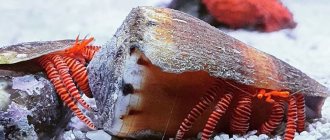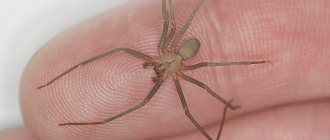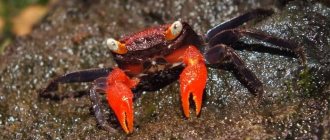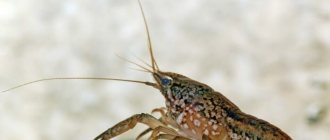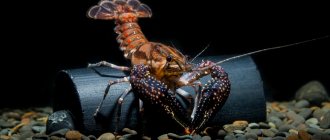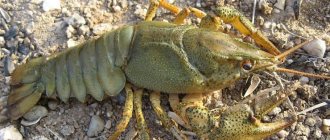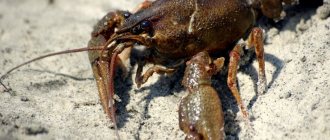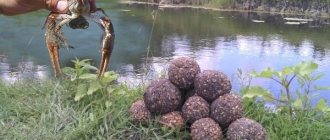Marine crustaceans
Simplicity of content:
Latin name: Pagurus Bernhardus
Lifespan: up to 11 years
Maximum size: 15 cm.
Average cost: from 500 rub.
The hermit crab belongs to the class of crustaceans. There are many species, each of which deserves attention, but not all hermits are suitable for keeping in an aquarium. And those that are suitable require some knowledge from the owner. Which ones? Let's find out in the article.
Origin of the species and description
Photo: Hermit crab
The hermit crab is a species of decapod sea crayfish, an infoorder of incomplete tails that inhabit the shallow waters of coastal zones of the subtropics and tropics. He is unpretentious in food, omnivorous. His main feature is that he always wears a shell. The shell that serves as a home for the hermit crab often comes from mollusks.
The entire back part of the crayfish’s body easily fits in the shell, while the front remains outside. A kind of shell house serves as excellent protection for the arthropod, so it never leaves it, but changes it as needed when its size increases.
Video: Hermit crab
Today there are a large number of different types of hermit crabs that inhabit all the seas of the planet. The largest species reaches 15 cm in size. The hermit crab is difficult to see, only in rare cases when it leaves its shelter. The body of an arthropod transforms over time to suit the characteristics of the shell in which it lives.
For additional protection, cancer has at its disposal many devices, incl. a layer of chitin abundantly covering the front part of the body. The shell serves to protect the animal from enemies. The hermit crab removes it during the molting period. Over time, a new layer of chitin grows again on its body. Old shells can serve as food for cancer.
Appearance and features
Photo: What does a hermit crab look like?
The sizes of hermit crabs vary and depend on its species. From the smallest 2 cm to the largest 15 cm. The appearance of the hermit crab is very unusual.
The body is divided into the following parts:
- soft body;
- head combined with chest;
- legs;
- mustache;
- claws
The claws are located next to the head. The right claw is larger than the left one. Cancer uses it as a gate to enter the home. The hermit uses his left claw to obtain food. The legs, which are used by arthropods to move, are located next to the claws. Other small limbs are not used by cancer.
The front part of the body is covered with chitin, which forms a fixed shell. The back soft part of the hermit crab's body is not covered with chitin, so it hides it in the shell. Small hind limbs securely fix the shell, so the arthropod never loses it.
Hermit crabs use shells of various mollusks as their houses:
- Rapanov;
- gibull;
- puss;
- cerithium.
For convenience, the arthropod chooses a shell of a size that exceeds its body. The large claw of the hermit crab reliably blocks the entrance to the shelter. Hermit crabs actively increase in size throughout their lives, so they are forced to constantly expand their living space. To do this, they change their shell to larger sizes as necessary, using only free ones. If a hermit crab for some reason does not find a suitable shell, it can move in with another relative.
Interesting fact: A hermit crab can use not only a mollusk shell as a house, but other objects of a suitable shape: a glass, a lid, etc.
Recommendations of an oncologist at the Dawn Clinic on skin cancer
The Oncology Department of the Rassvet Clinic provides the full range of diagnostics of tumor lesions of the skin, including biopsy and modern pathomorphological diagnostics. In the surgical department of minor oncology, it is possible to carry out surgical treatment using various types of plastic defect replacement.
We also work in partnership with a radiation therapy center, which allows us to provide modern radiation therapy techniques.
With a widespread process, modern chemotherapy and targeted therapy are possible. Treatment can be carried out even in very weakened patients, and our team of specialists provides all necessary accompanying therapy.
Additional recommendations from a doctor at the dawn clinic for the prevention of skin cancer
Since many forms of skin cancer are associated with ultraviolet exposure, a number of measures are recommended to reduce it:
- Use sunscreen. Ultraviolet radiation is a proven human carcinogen. Regular daily use of sunscreen SPF 15 or higher reduces the risk of developing skin cancer by approximately 40%.
- Use a sunscreen with broad-spectrum UVA/UVB protection, applied as directed (30 minutes before sun exposure, reapplied every 2 hours after swimming or sweating).
- Wear protective clothing: long-sleeved shirts, trousers and wide-brimmed hats.
- Avoid visiting a solarium. Those who ever sunbathed indoors had a 67% higher risk of developing squamous cell carcinoma and a 29% higher risk of developing basal cell skin cancer.
Author:
Absalyamov Ruslan Ildarovich oncologist
Where does the hermit crab live?
Photo: Black Sea hermit crab
Hermit crabs inhabit exclusively reservoirs with clean water. Therefore, a large population of these arthropods indicates a clean ecological situation in this place. Recently, the catastrophic situation with sea pollution has led to a sharp decrease in the number of hermit crabs.
Hermit crabs prefer to live in shallow water. But there are certain species that descend to a depth of 80 m under water. Today, hermit crabs can be found on the shores of Australia, in the Baltic Sea, the North Sea, on the coast of Europe, in the Mediterranean Sea, on the coast of the Caribbean islands, Crudasan Islands.
However, not all hermit crabs prefer to live in water. There are land hermit crabs that live on the islands of the Indian Ocean. They live on land almost their entire life. With their constant movement, land hermit crabs dot the entire coastal zone, and the trail left by arthropods resembles that of a caterpillar tractor.
For land arthropods, the issue of expanding their living space is very acute, since there is no particular choice of shells on land. Therefore, the hermit crab has to try hard to find the necessary housing. Land hermit crabs are found both on the sandy shores of the islands and in the forests of the coastal zone. However, most arthropods choose sea and fresh water to live.
Now you know where the hermit crab is found. Let's see what he eats.
What does a hermit crab eat?
Photo: Hermit crab in nature
In order to fully get to know the hermit crab, it is worth knowing its diet. In this way, the hermit crab is very similar to its relatives - crustaceans, which means it is also omnivorous and not picky. He does not disdain plant and animal food. His favorite delicacies are: algae, worms, fish eggs, shellfish, and fish.
It happens that a hermit crab can snack on carrion or food debris left over from nearby sea anemones. If, for some reason, the crayfish has to go to land, then they feed on coconuts, fruits or small insects.
When a hermit crab molts, it sheds its shell and eats it, since it consists of organic remains. This arthropod picks up any organic food. The region where the hermit crab lives greatly influences its diet. But in most cases, these are still algae, fish, worms, small crustaceans or echinoderms.
They mainly obtain food in the tidal coastal strip, or on some rocky surfaces. As for individuals living in aquariums, they can eat special food, or whatever is left on the dinner table, porridge, pieces of chicken, or any grocery products. To add some vitamins to his diet, you can feed him pieces of fruit.
Diagnostic methods
Diagnostics involves an examination by a doctor, as well as the following mandatory methods:
- Ultrasound;
- endoscopic examination;
- biopsy.
If the results of the biopsy confirm the presence of malignant cells, the patient is prescribed the following diagnostic methods:
- X-ray;
- CT or MRI;
- scintigraphy.
Multi-stage diagnostics allows you to accurately study the tumor and prescribe effective treatment to the patient.
Features of character and lifestyle
Photo: Hermit crab from the Black Sea
The hermit crab is distinguished by its courage and endurance. Since he is hunted by a large number of enemies, he has to defend himself all his life. That is why he drags the shell everywhere. Along with this, he tries in every possible way to “establish” contacts with his brothers, even to negotiate. To establish their comfortable living, hermit crabs can exchange shells.
The moment an arthropod changes its home, it becomes most vulnerable. For additional shelter from predators, the hermit crab hides under rocks and in gorges. But this shelter becomes extremely unsafe for him during low tides.
For some lonely hermit crabs, symbiosis with poisonous sea anemones is suitable. Such coexistence is mutually beneficial for both parties, since it helps to obtain food, and does not at all limit their independence. A striking example of such a symbiosis is the union of an arthropod and a sea anemone. Anemone settles on the shell of a hermit crab and uses it as a carrier.
Neighbors feed on each other's leftover food. Together they can easily fend off predators. I call such mutually beneficial symbiosis mutualism, and they do no harm to each other at all. The union breaks up only when the hermit crab is forced to change its shell due to an increase in size.
An adult hermit crab reaches quite a large size and becomes strong. The arthropod lives exclusively in clean water. The hermit crab is active in search of food at any time of the day. “Preparing” food and eating it takes him relatively little time.
Interesting fact: The hermit crab independently scouts and eats fish to the bone in just a couple of hours.
Habits
Mating games and the fight for a female in hermit crabs begin in the spring and can last all summer. The hermit mother carries the eggs inside her house. After maturation, young, larval-like crustaceans immediately float into the water column. Several more “rebirths” and molting will take place before the soft crustacean sinks to the bottom in search of its first home. It is necessary to find an apartment that is sized, because in a large space it will not be possible to spread out small legs. The period of adolescence for a hermit is the most difficult and unpredictable; at this time, a larger number of larvae will be eaten.
Every season the crustacean must grow, for this it is necessary to find a larger snail. The increase in size begins only after finding a new living space.
Hermit crabs are the beach cleaners of Anapa. They prefer dead underwater animals as food, thereby quickly cleaning the bottom. Thanks to hermit crabs, divers see a beautiful plain underwater.
Social structure and reproduction
Photo: Hermit crab
Hermit crabs, which live in water, prefer to stay with their fellows.
Living together with hermit crabs has the following advantages:
- the hermit crab does not need to waste energy searching for the right shell, since its fellow crabs “acquire” an expanded living space and leave their shell;
- It is much easier and simpler for hermit crabs to search for food together. As soon as one hermit crab finds food, he immediately informs the rest of his community about it;
- It is much safer to coexist in a group, since this way it is much easier to defend against enemies.
If at least three hermit crabs gather in one place, their other relatives crawl into the same place. A dozen arthropods form a “heap” in which everyone climbs on top of each other and tries in every possible way to throw each other off. In such a brawl, crayfish lose their shells. But at the same time, especially nimble individuals can acquire new and improved housing.
Land hermit crabs do not like to intersect with relatives precisely because of such gatherings. Left without shelter on land, it is difficult for them to find a new shell. The reproduction process of hermit crabs is based on competition between males and females. Reproduction of arthropods occurs all year round. During the process of their mating, eggs are produced, which they carry on their abdomen.
Interesting fact: A female hermit crab bears up to 15 thousand individuals.
After a week, larvae emerge from the eggs and are able to live independently in water. After four stages of molting, the larvae become small crustaceans that settle to the bottom. The primary task of young people is to find shelter in the form of a shell, so as not to become food for predators. In fact, only a few survive; even at the maturation stage, many larvae die. On average, a hermit crab lives 10 years.
Links[edit]
- ^ ab Patsy McLaughlin and Michael Turkey (2011). Lemaitre R., McLaughlin P. (eds.). "Paguroidea". World Database of Paguroidea & Lomisoidea
. World Register of Marine Species. Retrieved November 25, 2011. - ^ ab Patsy A. McLaughlin; Tomoyuki Komai; Raphael Lemaitre; Dwi Listyo Rahayu (2010). Martin E.Yu. Short; S. Tan (ed.). "An Annotated List of the Anomuranic Decapod Crustaceans of the World (Excluding Kiwaoidea and the Families Chirostylidae and Galatheidae of Galatheoidea) - Chapter: Part I - Lithodoidea, Lomisoidea and Paguroidea" (PDF). Zootaxa
. Supplement 23:5–107. Archived from the original (PDF) on January 22, 2012. - Hazlett, B. A. (1981). "Behavioral ecology of hermit crabs". Annual Review of Ecology and Systematics
.
12
(1): 1-22. DOI: 10.1146/annurev.es.12.110181.000245. ISSN 0066-4162. - Ray W. Ingle (1997). "Hermits and stone crabs (Paguroidea)". The Crayfish, Lobsters and Crabs of Europe: An Illustrated Guide to Common and Traded Species
. Cambridge University Press. pp. 83–98. ISBN 978-0-412-71060-5. - ^ ab Jason D. Williams; John J. McDermott (2004). "Biocoenoses of the Hermit Crab: A Worldwide Survey of the Biodiversity and Natural History of Hermit Crab Associates" (PDF). Journal of Experimental Marine Biology and Ecology
.
305
: 1–128. DOI: 10.1016/j.jembe.2004.02.020. Archived from the original (PDF) on March 04, 2016. Retrieved January 13, 2020. - W. D. Chapple (2002). "Mechanoreceptors innervating the soft cuticle in the abdominal cavity of the hermit crab Pagurus pollicarus
."
Journal of Comparative Physiology
A.
188
(10):753–766. DOI: 10.1007/s00359-002-0362-2. PMID 12466951. S2CID 7105940. - W. Michael, Scott. "Aquarium hermit crabs". Fishchannel.com
. - Elena Tricarico; Francesca Gherardi (August 2006). “Getting a shell by hermit crabs: which tactic is more effective?” (PDF). Behavioral ecology and sociobiology
.
60
(4): 492–500. DOI: 10.1007/s00265-006-0191-3. HDL: 2158/210264. S2CID 23622893. - ^ a b Randy D. Rotjan; Jeffrey R. Chabot; Sarah M. Lewis (2010). "The social context of shell acquisition in the hermit crab Coenobita clypeatus". Behavioral Ecology
.
21
(3):639–646. DOI: 10.1093/beheco/arq027. HDL: 10.1093/beheco/arq027. ISSN 1465-7279. - ↑
Jennifer E. Angel (2000).
"The influence of the shell on the biology of the hermit crab Pagurus longicarpus
(Say)".
Journal of Experimental Marine Biology and Ecology
.
243
(2):169–184. DOI: 10.1016/S0022-0981 (99) 00119-7. - ↑
Ferris Jabr (June 5, 2012).
"On a tiny Caribbean island, hermit crabs form complex social networks". Scientific American
. Scientific American. Retrieved November 6, 2014. - ↑
Robert Sanders (October 26, 2012). "Hermit crabs are socialized to drive away their neighbors". University of California at Berkeley. Retrieved October 27, 2012. - ↑
Lewis, Sophie (7 December 2022).
"Plastic pollution killed half a million hermit crabs who confused trash for shells". CBS News
. - A. Klitsper; Paul D. Taylor; H. Westphal (2013). "Bryolites constructed by bryozoans in symbiotic associations with hermit crabs in a tropical heterozoic carbonate system, Golfe d'Arguin, Mauritania." Marine Biodiversity
.
43
(4):429. DOI:10.1007/s12526-013-0173-4. S2CID 15841444. - Grubb, P. (1971). "Ecology of terrestrial decapod crustaceans on Aldabra". Philosophical Transactions of the Royal Society
B.
260
(836):411–416. Bibcode: 1971RSPTB.260..411G. DOI: 10.1098/rstb.1971.0020. - Jump up
↑ Squires, H. J. (1996).
"Larvae of the hermit crab Pagurus arcuatus from plankton (Crustacea, Decapoda)" (PDF). Journal of Northwest Atlantic Fisheries Science
.
18
: 43–56. DOI: 10.2960/J.v18.a3. Archived from the original (PDF) on July 16, 2011. - "Hermit Crab Care Guide". Home smart veterinarians. Smart pet. 2006. Archived from the original on 2011-06-11. Cite journal requires |journal= (help)
- ↑
Lombardi, Linda (July 22, 2008).
“Hermit crabs should not disappear; with proper care they can live a long life." Amherst Daily News
. Associated Press. Retrieved July 7, 2022. - ↑
Stacey (February 21, 2013). “How old is my hermit crab?” . Crabstreet Magazine. Retrieved April 28, 2013. - JD MacDonald; RB Pike; DI. Williamson (1957). "Larvae of the British species Diogenes, Pagurus, Anapagurus
and
Lithodes
".
Proceedings of the Zoological Society of London
.
128
(2):209–257. DOI: 10.1111/j.1096-3642.1957.tb00265.x. - ↑
C. W. Cunningham;
NW Blackstone; L. W. Buss (1992). "Evolution of Kamchatka crabs from the ancestors of hermit crabs." Nature
.
355
(6360):539–542. Bibcode: 1992Natur.355..539C. DOI: 10.1038/355539a0. PMID 1741031. S2CID 4257029. - C. L. Morrison; A. W. Harvey; S. Lavery; K. Thieu; Y. Huang; C. W. Cunningham (2001). "Mitochondrial gene rearrangements support parallel evolution of the crab-like form" (PDF). Proceedings of the Royal Society B: Biological Sciences
.
269
(1489): 345–350. DOI: 10.1098/rspb.2001.1886. PMC 1690904. PMID 11886621. - Tsang, L.M.; Chan, T.-Y.; Ahyong, S.T.; Chu, K. H. (2011). "Hermit to King, or Hermit to Everyone: Multiple Transitions to Crab-Like Forms from Hermit Crab Ancestors". Systematic biology
.
60
(5): 616–629. DOI: 10.1093/sysbio/syr063. PMID 21835822. - Patsy A. McLaughlin; Raphael Lemaitre (1997). “Carcinosis in anomora - fact or fiction? I. Evidence from adult morphology". Contributions to Zoology
.
67
(2):79–123. DOI: 10.1163/18759866-06702001. PDF - ↑
Sammy De Grave;
N. Dean Pentcheff; Shane T. Ahen; and others. (2009). "Classification of living and fossil genera of decapod crustaceans" (PDF). Raffles Zoological Bulletin
. Suppl 21:1–109. Archived from the original (PDF) on 06/06/2011. - Rene HB Fraaije; Adiel A. Klompmaker; Pedro Artal (2012). "New species, genera and family of hermit crabs (Crustacea, Anomura, Paguroidea) from the mid-Cretaceous reef of Navarra, northern Spain." Neues Jahrbuch für Geologie und Paläontologie
.
263
(1):85–92. DOI: 10.1127/0077-7749/2012/0213. - Rene H. Fraaije (January 2003). "The oldest in situ
hermit crab from the Lower Cretaceous of Speeton, UK."
Paleontology
.
46
(1):53–57. DOI: 10.1111/1475-4983.00286. - ↑
Mironenko, Alexander (January 2022).
"A hermit crab preserved inside an ammonite shell from the Upper Jurassic of central Russia: implications for ammonoid paleoecology". Paleogeography, paleoclimatology, paleoecology
.
537
: 109397. doi: 10.1016/j.palaeo.2019.109397. - Fraaije, Rene; Schweigert, Günter; Nuetzel, Alexander; Gawlik, Philip (01/01/2013). "New Early Jurassic hermit crabs from Germany and France". Journal of Crustacean Biology
.
33
(6):802–817. DOI: 10.1163/1937240X-00002191. ISSN 0278-0372.
Natural enemies of hermit crabs
Photo: What does a hermit crab look like?
The soft, nutritious body of the hermit crab is of interest to many marine inhabitants. An unprotected hermit crab is a tasty morsel for predators. Most enemies find it very difficult to get a hermit crab out of its shell. Not only does the well-fed body of the arthropod completely fill the free space of the shell, but also the hermit crab tightly holds the shell with its hind limbs. Additional protection for the hermit crab is provided by the sea anemone, which lives with it in symbiosis.
But every hermit crab has to deal with a change of place of residence. When he leaves his shell in search of a larger home, he becomes prey for sea creatures. Any marine animal that is larger than a hermit crab becomes its enemy. Its main enemies are cephalopods, octopuses, and squids. Their powerful, developed jaws easily quickly bite through even a protective shell. Therefore, they pose a great danger to the hermit crab, even when he is in the house.
The hermit crab larva is exposed to danger at every corner because, unlike the adult, it does not have a protective house. Hermit crabs become victims of parasites of isopods and rhizomes.
